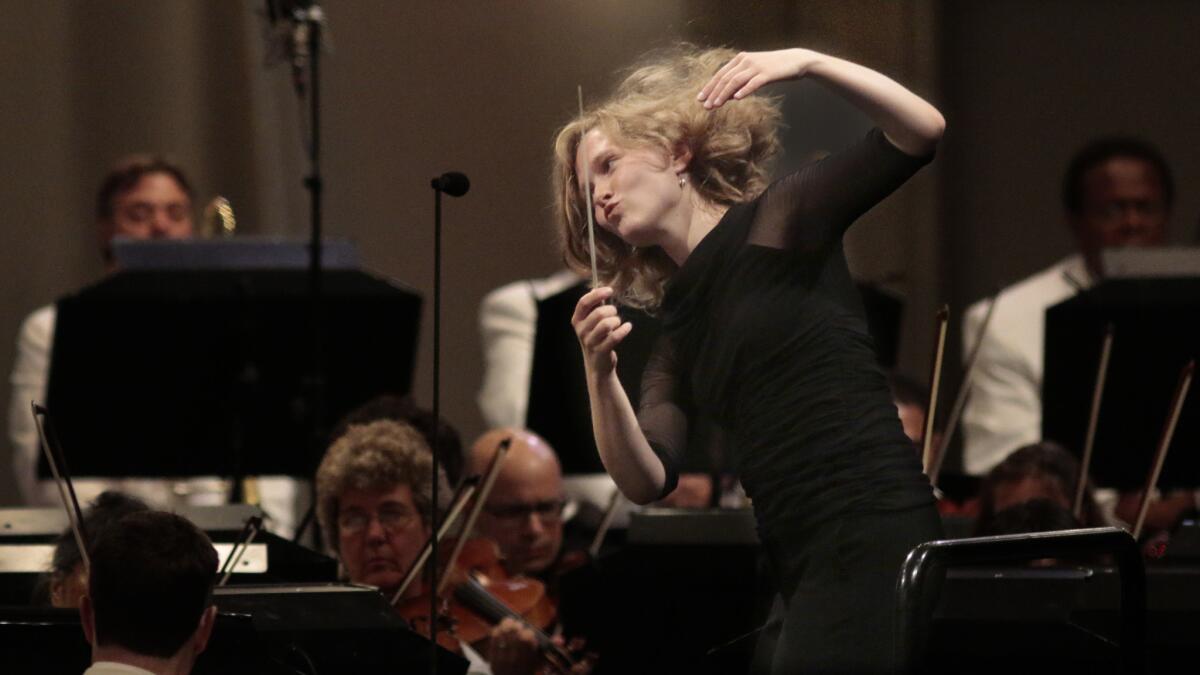Review: Mirga Grazinyte-Tyla makes great first impression

- Share via
This review has been corrected. Please see below for details.
My guess is that before long she will be known simply as “Mirga.”
But to call 28-year-old Lithuanian conductor Mirga Grazinyte-Tyla by her first name after her Hollywood Bowl debut Thursday night is more out of awe — as we do Napoleon or Joan (of Arc) — than familiarity or convenience. Winner of Salzburg’s young conductor competition in 2012 and appointed Los Angeles Philharmonic assistant conductor last week, she is a natural leader and a musical force of nature.
The last time a young conductor strode onto the big Bowl stage for the first time as though the long walk to the podium were a victory parade, it was a 25-year-old with curly hair from Venezuela, and you know how that turned out. Facing the orchestra, Mirga Grazinyte-Tyla (pronounced MEAR-ga GRA-chin-tee-eh TEE-la) flashed a gleeful let’s-show-’em-what-we-can-do smile.
Her conducting style is striking. Standing erectly with her legs apart and stationary, she operates from her upper body, vivaciously waving her arms as though corralling the musicians. She is compelling on camera, but she would also have been compelling had the Bowl turned off its video screens.
Her physical vehemence may produce predictably arresting results. But her ear for odd sounds and indifference to Romanticism in a program that began with Brahms’ Double Concerto (featuring L.A. Phil principal cellist Robert deMaine and guest violinist Alina Pogostkina) and ended with Mahler’s effusive First Symphony, gives the impression of a surprising, if aggressive, modernity.
Intriguingly, Grazinyte-Tyla, whom Gustavo Dudamel invited to be part of his L.A. Phil training program after she won the Salzburg prize, was keen to introduce herself here with one of Dudamel’s signature pieces. He inaugurated his first season as L.A. Phil music director with Mahler’s First at Walt Disney Concert Hall in 2009, recorded it for DVD and included it on his first U.S. tour with the orchestra.
Grazinyte-Tyla’s new job as L.A. Phil assistant will include covering for Dudamel and stepping in, if necessary, at the last minute if he cancels. Yet, other than the quality of appearing to be an innate conductor alert to every note in the score, she led a Mahler’s First that was as radically different in approach to Dudamel’s as could be reasonably imagined.
The symphony opens with a quiet evocation of nature, a misty atmosphere created by eerie strings and broken by cuckoo calls. Dudamel’s style is to stand for almost a full moment in silence to get everyone in the right mood before evoking colorfully inviting surroundings. Grazinyte-Tyla, with remarkable confidence and zero patience, eagerly launched in. Her forest was equally eerie, but in a steely futuristic way.
A listener at the Bowl relies on the amplification, but unless the sound crew went crazy twisting dials outrageously, those fascinatingly weird kinds of inner details were Grazinyte-Tyla’s. They weren’t fussy or perverse, given that Grazinyte-Tyla’s ferocious drive allows a listener no time to linger. You are instead swept away.
Grazinyte-Tyla shows little concern for Mahler’s creamy lyricism. She’s not much into a Viennese lilt. She’s not a dancer and does not delight in his klezmer outbursts. Nor is she a triumphalist, and she intriguingly underplayed Mahler’s final apotheosis. Her intensity never lets up.
The big storm that opens the last movement is definitely her territory. And the orchestra in general is her property. She manipulates sounds like a sorcerer. Agree with her or not, she’s on top of everything every second and clearly thrilled to be so.
The orchestra gave her everything she wanted, brightly and brilliantly, looking and sounding equally thrilled to go along with her for this wild ride.
Brahms’ late Double Concerto is often treated these days as a work of mellow maturity, a vehicle for a soulful solo cello and enraptured solo violin. In fact, Brahms score also benefits from a forceful conductor, not just for propulsion but also to egg on the soloists, who, in the best circumstances, can seem almost like jazz players responding to, and competing with, each other.
With Pogostkina a late replacement for an ailing Hilary Hahn, the soloists, no doubt out of necessity, accommodated, rather than challenged, each other. Pogostkina and DeMaine are athletic players, but with different manners. She is a light-toned violinist who phrases in a goal-directed manner. He is a more properly Brahmsian, with the required rapture and a winning way of making the moment matter. Grazinyte-Tyla moved the game along.
Under the circumstances, soloists and conductor made a moderate success out of trying conditions that include little rehearsal, and the last movement had a lilt that brought to mind Samuel Beckett’s great line about Brahms: “That old piddler! Pizzicatoeing himself off in the best of all possible worlds.”
The announcement of her new L.A. Phil appointment included the news that she would conduct the orchestra at Walt Disney Concert Hall on March 1, 2015; the program is still to be determined. In addition, she could be called in at a moment’s notice.
Expect to be hearing much more about Mirga as she pizzicatos herself off toward a major career, and the sounds of any remaining glass ceilings in the conducting profession shattering.
For the record, 11:15 a.m. Aug. 11: An earlier version of this review incorrectly said that Mirga Grazinyte-Tyla was not scheduled to conduct any subscription concerts during the upcoming L.A. Philharmonic season.
Twitter: @markswed
More to Read
The biggest entertainment stories
Get our big stories about Hollywood, film, television, music, arts, culture and more right in your inbox as soon as they publish.
You may occasionally receive promotional content from the Los Angeles Times.










